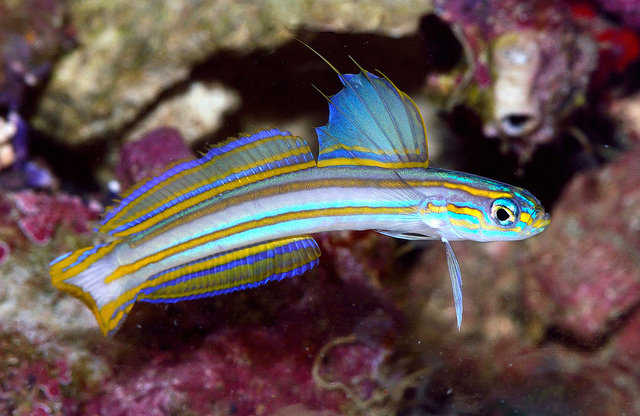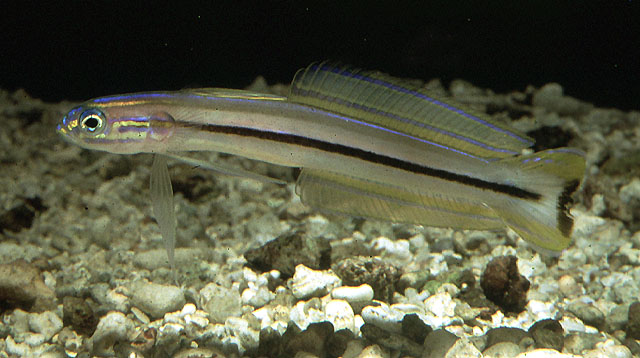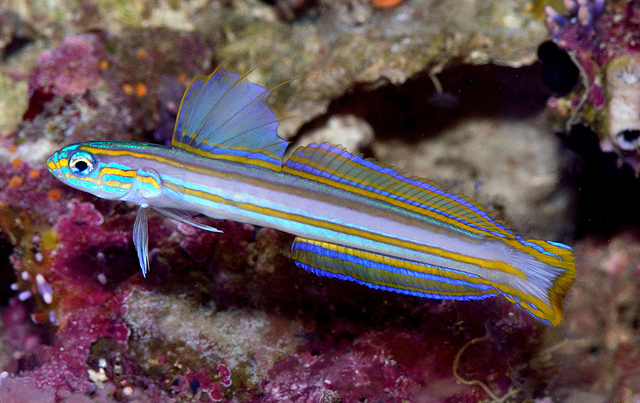
Ptereleotris grammica with fins fully expanded. This exquisite species is as beautiful as it is shy, and requires a very peaceful tank with low traffic. Photo credit: Lemon TYK.
Of the available ptereleotrine fishes, none are quite as spectacular or alluring as the genus Ptereleotris. These slender, slippery fishes are quite diverse, forming distinct clades with a myriad of species adopting various characteristic differences in their morphology and preference for habitat. Of which, the hanae and grammica clades are specialists of open, sandy bottoms far removed from the typical coral reef. This habitat is often monotonous and barren, with the silty substrate offering perfect conduits for the construction of vertical holes. Stonogobiops and Ptereleotris are frequently encountered here, and the latter are often seen taking up residence with the former and its shrimp partner.

Ptereleotris grammica. Note the numerous yellow lines that gives this species its namesake moniker. Photo credit: Lemon TYK.
Because of their preferred habitat and difficulty in catching them, these Ptereleotris are far from common in the aquarium hobby, occurring only in sporadic flashes of availability, with each event usually offering no more than one or two individuals. None is perhaps quite as exuberant as Ptereleotris grammica, the Lined Dartfish. The specific epithet “grammica” is rooted in the greek for “line”, which is very aptly displayed in yellow along all median fins and its body. The dorsal fin is characteristic for this species (and all other species in its clade), being winged and deeply crenulated between the rays. In the correct lighting, Ptereleotris grammica scintillates with a metallic blue glitter along the margins of its stripes and fins; a highly fetching and grandiose compliment to its already stunning beauty.
P. grammica is shy and retiring, and will fail to thrive in a bustling community tank. This species displays beautifully in a quiet biotope with low human and fish traffic, stocked with similarly well-behaved fish of petite stature and dainty behaviour. The species is distributed across much of the Western Pacific, from the Ryukyu Archipelago, south to the Philippines, Indonesia, the Bismarck Archipelago and the Great Barrier Reef. The species is replaced by a closely related sister in the Western Indian Ocean, a sister which only attained species status after serving as an invalid subspecies of P. grammica.

Ptereleotris melanota, previously known as P. grammica ssp. melanota. Photo credit: Daniel Pelicier.
Ptereleotris melanota is essentially identical to Ptereleotris grammica, sans the equatorial stripe and outermost caudal margin in black (hence the article title). The species was regarded as a subspecies of P. grammica by Randall and Lubbock, but was later elevated to full species. Curiously, the usage of subspecific statuses in ichthyology is very much lacking as compared to terrestrial organisms. P. melanota is the geminate twin here, occupying a distribution in the Western Indian Ocean, specifically in the Maldivian and Mauritius regions. The species is also known from South Africa.

Ptereleotris melanota. Note the lateral black stripe and the caudal margin. Photo credit: Allen D Connell.
Ptereleotris melanota is exceedingly rare, known only from a handful of specimens. Like P. grammica, is frequents open, rubble or sandy flats away from reefs in fairly deep waters. It is known in the aquarium trade from a single specimen collected in Mauritius, where it was later sold in Hong Kong. It is unlikely that the species was intentionally targetted for collection, but as long as aquarium collection continues to occur in Maldives and Mauritius, there is a small chance of re-encountering this elusive species. Ptereleotris grammica, on the other hand, is more easily procured, and for a change of scenery, perhaps a sandy bottom biotope complete with a group of these hovering dart fishes would make for a fascinating conversation starter.










0 Comments